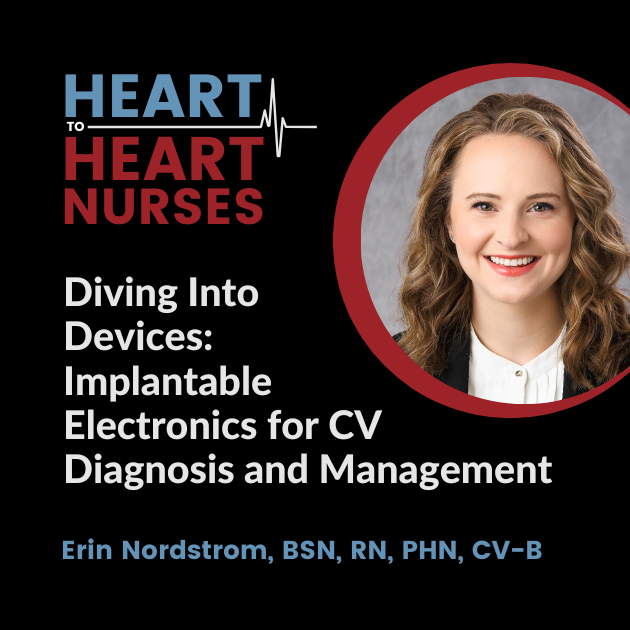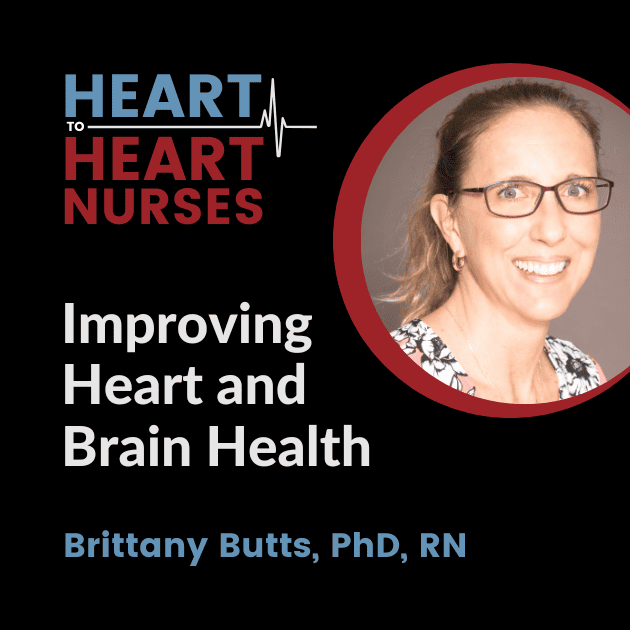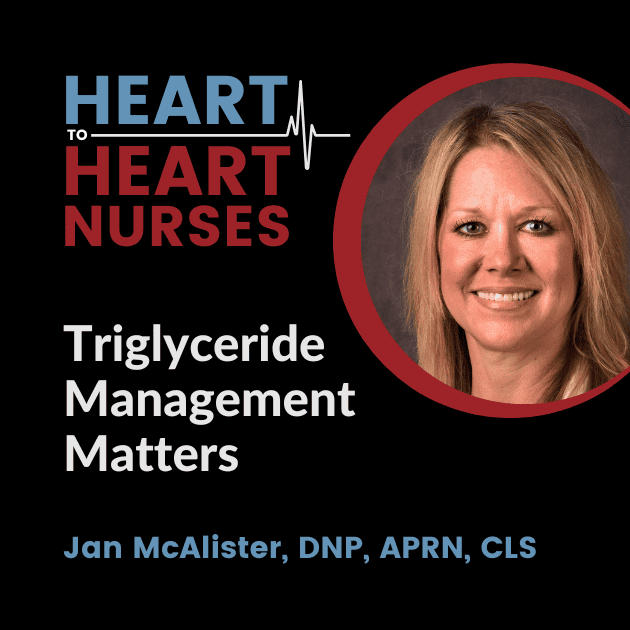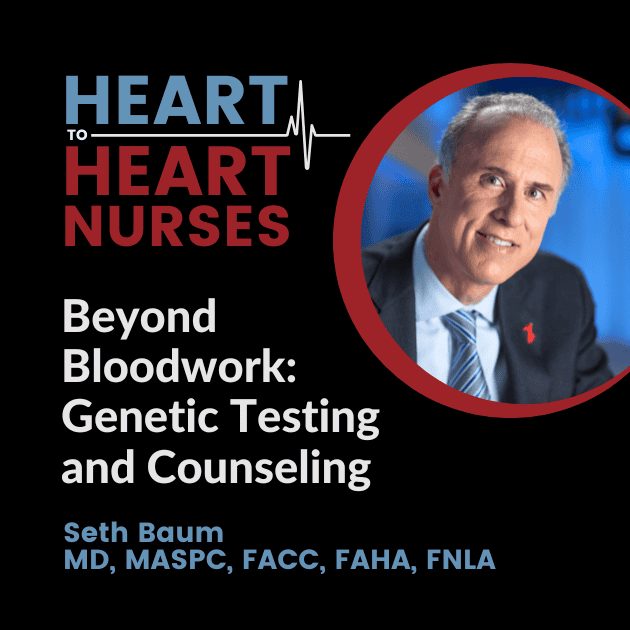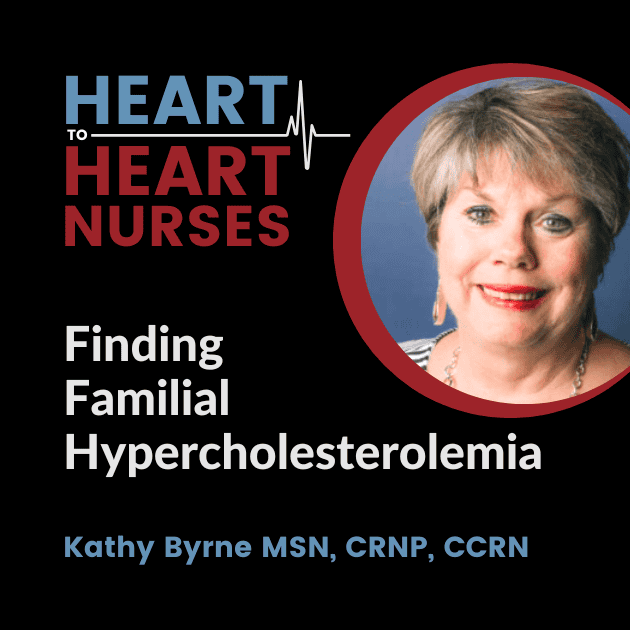Episode Resources
Welcome to Heart to Heart Nurses, brought to you by the Preventive Cardiovascular Nurses Association. PCNA's mission is to promote nurses as leaders in cardiovascular disease prevention and management.
Geralyn Warfield (host): I’d like to welcome our audience to today's episode where we have Lola Coke in the studio. Lola, could you tell us a little bit about yourself?
Lola Coke (guest): Yeah. So, thanks for having me first of all, Geralyn. It's always a pleasure to do these for PCNA. I am currently an Associate Professor and Cardiovascular Clinical Nurse Specialist at Grand Valley State University's Kirkoff College of Nursing. And I'm in more of an academic role these days: Director of Strategic Initiatives for the College of Nursing. But I continue to be very active with American Heart Association, and the National Action Plan for Peripheral Arterial [00:01:00] Disease. And so that's why I really appreciate the opportunity to talk more about that with you today.
Geralyn Warfield (host): Great. Well, our conversation is going to cover a couple different topics, as we described before we came on air. And last time we talked, which has been a while, in that particular episode, we talked about the importance of clinicians being able to recognize PAD, and how that affects our patients.
And today we're going to shift gears just a little bit and talk about the connections between smoking and PAD. So, could you start us off and give us a little bit more detail about that?
Lola Coke (guest): Yeah, absolutely. So, the connection between smoking and PAD. Well, first of all, PAD continues to be a very misdiagnosed disease because the early symptoms—like leg pain, extremity numbness and tingling—are also symptoms of other chronic conditions. And oftentimes are connected because of smoking and the vascular effects of nicotine [00:02:00] on the peripheral arterial system.
PAD also continues to be very disparate in African American and Hispanic populations more so than whites. And we know that in terms of smoking, that those populations continue to smoke more than the Caucasian population. And so that's kind of the connection.
Patients with PAD also have other comorbid conditions like hypertension, diabetes. And they have those multiple risk factors—smoking being really a very, very important one, along with things like obesity, being sedentary and, of course, not always great nutritional management.
So, smoking cessation in my mind is one of the most important risk factors to focus on in the PAD patient.
However, the best strategy in working with patients with PAD is not to say, “We need to work on smoking cessation,” but maybe to use the other risk factors that they have. Find [00:03:00] out what they're most motivated to work on first, develop that toolkit for change, and then apply it to smoking cessation in tandem with really emphasizing the importance of smoking cessation as being really a very important one for them to think about quitting.
So, once they build that toolkit, then we can move towards strategies for smoking cessation.
Geralyn Warfield (host): So, one of the things that we will need to keep in mind as we are making the connections for our patients between smoking and PAD and all those other comorbid conditions that you've described, or all those other issues that they're dealing with, is communicating effectively.
And all of us that work in clinical settings recognize the importance of effective communication, but we also recognize that sometimes there are some barriers, particularly in complex, difficult kinds of things like smoking cessation. It's not enough for us to say, “You need to stop smoking” [00:04:00] and then go on with the rest of the visit.
There’s a lot more to it that than that. So, I'm hoping you might help our audience think about some effective strategies in situations where there are some complexities there.
Lola Coke (guest): Right. And you bring up a really good point, and that is, it is a difficult conversation because it's such a hard habit to break. You know, it's an addictive habit. Nicotine is addictive.
And other risk factors like adding exercise, reducing sodium in your diet, are easier to accomplish. And so, I always put smoking cessation in that category of ‘difficult conversations’ because patients are most resistant because it's so addictive. And it's just not as easy as turning off the smoking button and turning it back on if they want to.
It really is important that we’re persistent and we really help them with this difficult decision.
So, in terms of [00:05:00] strategies for clinicians in working with patients in this difficult conversation about smoking cessation, I really like to take the time to gauge where the patient is in their desire to quit smoking first. That gauges their resistance, how difficult the conversation is going to be.
I like to use the Trans-theoretical Stages of Change model by DeClemente and Prochaska as a guide. There's five stages in this model, and it starts with pre-contemplators. Then it goes to contemplators, then preparation stage, action stage, and then maintenance.
Individuals who are pre-contemplators and contemplators are not ready to change. And so don't bother putting together a plan or telling them what to do, because they're just not ready. So, it's important to be persistent in talking to them about changing, using motivational interviewing, which we talked about in a prior podcast, to remove the [00:06:00] resistance and ambivalence that they feel about changing that smoking behavior.
At each stage, the healthcare professional can work with the patient to move them toward that preparation stage, which is where they begin to develop a plan for change.
The pre-contemplators, again, have no intention of changing or taking actions in the near future. You can actually put a little time element to it; as opposed to the contemplators, that they're thinking about it. And it will take a month or a little bit more for them to begin to think about a preparation phase. So, there's a little time element that we know from the science when we're talking to our patients.
So, what do we do with each of these changes?
Well, the pre contemplators: we give them educational material, we're persistent in discussing it with them. We're always trying to use motivational interviewing to chip away at ambivalence and resistance.
When we see the contemplators, [00:07:00] knowing that we're starting to hear a little change talk, they're thinking about the lifestyle change, they might be making that change in the next month or so. Then we ask them to explore past successes and failures.
And I like to use in motivational interviewing, looking back and looking forward. So, looking back, would be asking your patient, “In the past when you tried to quit smoking, what worked? What didn't work? If you fast forward six months, what do you think it would look like if you quit smoking? What do you think it would look like if you didn't quit smoking?” And trying to get them to explore their own arguments for those changes. And so, it’s important to weave motivational interviewing as a communication technique, even in those difficult conversations.
So, once they start to explore their successes and their failures, then we use those to build that toolkit for that preparation phase. [00:08:00] When we hear change talk, that's when we start with that preparation phase and begin to develop a plan for change. It's very important in developing a plan for change that we set realistic goals. They should be SMART goals. But also, you have to build in a tremendous amount of follow-up and a tremendous amount of incentives.
Smoking cessation has a very, very high relapse, as all lifestyle change does, but in particular, smoking has a very, very high, relapse, times of relapse. And so, it's really important that follow-up and incentives and supports and reinforcement are built in. It's a tough, addictive habit to break and it takes time.
Once you develop the action plan with all of those things, then each encounter then should be, focused on [00:09:00] evaluating the goals. “How did those incentives work? How did the reinforcement work? What can we do differently” And again, with a self-care, self-management lens, decision-making lens on the part of the patient. They need to be driving the bus.
It generally takes about 30 days to develop a habitual change. And so that's where, as I mentioned before, we really have to focus on getting all of those incentives and follow-ups intensified in that first 30 days. So, promoting the self-care. Ownership of our own behaviors are really important.
And then lastly, as we move to the maintenance phase, patients need to envision their smoking cessation, just like addiction from alcohol or other illicit substances because it is truly addictive with nicotine. [00:10:00]
And continue to work on what we talked about before as relapse. Discussing how relapse might occur, developing a plan for those high-risk situations, is really important in the maintenance phase.
So, they're ready, they're motivated, they have a plan. Now it's keeping them moving on that plan, keeping them going. Smoking cessation is a lifestyle change that's lifelong and has to be worked on really forever. And so, as a healthcare provider, it, we have to keep that in mind too, that we're going to be a partner with them for a really, really, really long time.
Geralyn Warfield (host): We've been in conversation with Lola Coke about behavior change, particularly with a focus on smoking cessation as it relates to PAD. We're going to take a quick break, and we will be right back.
Geralyn Warfield (host): And we're back for more discussion with Lola Coke. And you had mentioned that this is a lifelong kind of [00:11:00] conversation, a lifelong commitment on the part of the patient and by a healthcare professional.
So, as we're thinking about that long-term commitment by both of us, we recognize that there might be multiple touch points, that there's going to be ongoing conversation, that there's going to be backslides, and there's going to be things to celebrate along this great continuum of helping our patients live their healthiest life.
So how can we ensure that the conversations that patients are hearing are nonjudgmental, that everybody that's part of the care team is kind of sharing it in that way and not. Providing guilt, not accusing, not thinking of blaming the patient. How can we put that into practice?
Lola Coke (guest): Yeah, that's a really, really important point and a really good question. You know, because there are so many multiple touch points and it takes so long, and as I mentioned before, there are many, many times there's [00:12:00] relapse, you know, as both the patient and the provider you can get really frustrated. And you can think, you know, “Why am I doing this?” You know I thought we were making progress and now we're no. We're taking two steps back instead of two steps forward.”
And so, as providers, healthcare providers, it's often easy, and I've seen this in my practice over the years, really when we're frustrated to engage in, you know, fear tactics, which is sort of the old way we used to approach things with patients that were really resistant. You know, saying things like, “You know, if you don't quit smoking, you know you're going to die.” Or you know, in our PAD patients, “You know, if you don't quit smoking, we're going to have to amputate your legs because your circulation's going to get worse.”
And of course, fear tactics, we know from the literature there's actually been studies which tell us that fear tactics rarely work. Just like knowledge alone doesn't work. You know, knowledge has some power, but if knowledge alone worked, nobody would be smoking, right? Because we [00:13:00] know so much about the harmful effects of smoking.
So, we know those tactics have not shown to be successful.
And so, what we can do though in motivational interviewing is using a technique called provoking extremes. And so, this is a technique where the healthcare provider says things like, “You know, we've been working for a lot of weeks and we've tried a number of things, and in terms of your journey of smoking cessation, you're still not making any progress.”
“What do you think's the worst thing that's going to happen if you don't quit? What do you think's the best thing that might happen if you did decide to quit?” And let the patient develop again, their own arguments. Let them stop and take pause and say, “Well, okay, well maybe this and this and this.”
And yes, you could say, “Based on the damage to the blood vessels in your legs in your future could be something like, you know, removal of [00:14:00] toes or limbs or things like that.” Those are some things that are going to happen in real life if the patient doesn't help to change their lifestyle.
But trying to scare them is not the right approach.
But integrating it in as part of a teachable moment would be really the right approach to take with this. “Where do we go from here?” You know, just asking the patient, “I've been working with you for months. Where do we go from here? It's nice seeing you all the time, but we're not making any progress.”
And that alone, I have found, sometimes can make them feel like, “Oh, Yeah, maybe I haven't put forth my best effort.”
And in that case then that's where you can provide some affirmations. You know, again, “You've been persistent, you've come to all the appointments. Your wife is trying to support you” (or your spouse), things like that. Trying to really capitalize and provide positive, wherever you can.
Sometimes even, I ask the patient [00:15:00] to think back to a family member or a long-time friend or, you know, maybe a worker, somebody they work with that has been a long-time smoker and has had some problems, and. “What did that look like?” and “How did that impact their quality of life and their family?”
And again, having them relate to somebody else's story can also be powerful. You know, smoking in and of itself isn't a hereditary thing, but it's certainly a programmed, habit, you know, if dad smoked, grandpa smoked, or in some professions, some bodies of work, smoking is sort of part of the lifestyle, or the socialization.
And so, trying to get them to think about “What did it look like when John had to go in and have surgery because of his smoking?” And so that can also be very, very powerful.
And then to answer the piece of your question about the, the healthcare team, [00:16:00] it's vitally, vitally important that all members of the healthcare team are on the same page—Where is this patient in their stages of change? What are we all doing to help the person in their stages of change?—so we send consistent messaging. Having care team meetings, having the electronic health record where we can keep notes, are all of course effective ways to make sure communication's effective.
And with smoking cessation if they're there for other comorbid conditions—they're seeing a dietician, they're seeing a physical therapist. Again, if everybody could send the same message, then the patient's getting that and that reduces confusion, but yet continues to, to send the message “Boy, if everybody on my team thinks this is important, then maybe I really do need to pay attention.”
So, I think that's a really effective way that the healthcare team can all work together.
Geralyn Warfield (host): I think you've really hit upon an [00:17:00] important point that is not just for this particular topic, but it really is that coordination of messaging. In this case, it's of course very important because if you only hear it from one of your healthcare providers and nobody else seems to really care, then it doesn't kind of carry the weight, I think, in your mind.
Lola Coke (guest): Right.
Geralyn Warfield (host): Whereas if two or more, or if every single visit with every single type of person in healthcare that you see is asking you about it in a kind, supportive understanding, ‘we want to help you’ way rather than a punitive way, I think that goes a really long way, doesn't it?
Lola Coke (guest): Right. Absolutely. And then as you know, different diagnostic tests are performed that maybe show progression of PAD because of the smoking, as we deliver those pieces of bad news, same thing. You know, I think it's important when we deliver the bad news that the rest of the healthcare team knows that that news has been delivered and that everybody can come alongside that [00:18:00] patient and provide that support.
And then again, if there's surgical interventions that need to happen, other kinds of care aspects that need to occur, that everybody works together to meet those patients’ social determinants of health, their resources, but also, it's vitally important about that support and follow-up.
Geralyn Warfield (host): So, we know from the perspective of behavior change that slips and slides are part of the process. You already kind of mentioned that in an earlier part of this particular episode, and I suspect for individuals who are trying to stop—they're trying to work on tobacco cessation or they have PAD—that when these slips happen, I suspect, like for many of us there can be more devastating or more distressing.
So how can providers help with that kind of feeling?
Lola Coke (guest): Right. And that, and that gets into that, that whole, probably maintenance phase, but really all [00:19:00] along those stages of change. And that gets to the thinking about relapse, right?
So, if we're talking to a patient about their smoking cessation, or another lifestyle change for that matter, when there's a relapse, we need to make sure we set the stage that they'll talk to us about it. Because one of the things that happens often with providers, and I don't think they intend to do this, but patients won't discuss it with them because they don't want the provider to know. They don't want to disappoint the provider. Or the provider for some reason in their communication style, makes them feel guilty. Right?
And nobody likes that. Nobody wants to feel guilt or, “Ooh, I did a bad thing,” right? “I'm a bad person because I smoked when I said I wasn't going to,” for example.
And so, it's really, really important as you're developing the plan and the preparation phase to let the patient know there will be relapse. “Relapse is normal. We expect it. It's part of the [00:20:00] journey.”
“I need to know when you relapse, I need to know the details about the relapse, I want you to think about why you relapsed.” And that helps us then to revise goals, to maybe add different reinforcements or incentives, and certainly those rehearsals for relapse.
So, for example, you're at work and at 9:30 when the bell rings, everybody goes for coffee, right? It's a structured factory environment, for example. In that type of work relationship, everybody's on the loading dock and all of a sudden everybody's like, “Well, how come you're not smoking? Ooh, look at you.”
To be able to rehearse that and to have an appropriate response. And to be able to handle that without being brow beaten or intimidated by your peers to have that relapse. And so all of those things are important pieces to rehearse and to plan [00:21:00] for. So, it's really, really important to really help the patient plan for those kinds of times when that happens.
And so motivational interviewing would say, we have to hear their story, right? “What's your typical day? When are you going to relapse? When do you smoke? What does that look like? Where do you think you can cut back? Where do you think you could make that change?” And so, all of those parts are part of relapse and relapse planning.
Smoking cessation, of course. In terms of slips and slides, a big part of it is support. Smoking cessation programs were a little more predominant years ago. And now with budget efficiencies, a lot of health systems don't have those programs anymore. But there are groups and there are hotlines and there are sometimes one-to-one smoking cessation places you can go, psychologists or social workers that do that work.
And [00:22:00] so, guiding the patient about what are the options available geographically, that are realistic for them and then finding the best fit. You know, some people don't like a group. Some people like a one-on-one, other people like a group and don't like a one-on-one. So, it's important to find out what best works for the patient.
And then with our newer just-in-time interventions like texting, a telehealth call, things like that, that may be very effective too. And so you're in constant contact or frequently contact with that patient. They're not very expensive. They just take a little bit of time.
A member of the team can do that support for you. It doesn't always have to be you, yourself, but another nurse or another member of the healthcare team. So, we're building that whole relapse plan.
So at the end of the day, smoking cessation's hard. And it can be a very, very frustrating lifestyle habit for both the provider and the [00:23:00] patient to work with.
And so, open communication, empathic communication, you mentioned that before, persistence, are really what's so vital for success.
Geralyn Warfield (host): Lola, thank you so very much for spending time with us today, inspiring as well as educating our audience about what it takes to be effective in these behavior changes, particularly the difficult ones related to smoking and helping to support our patients with PAD.
We're really grateful.
Lola Coke (guest): Thank you. It's been my pleasure.
Geralyn Warfield (host): This is your host, Geralyn Warfield, and we will see you next time.
Thank you for listening to Heart to Heart Nurses. We invite you to visit pcna.net for clinical resources, continuing education, and much more.
Subscribe Today
Don't miss an episode! Listen to the Heart to Heart Nurses podcast on your favorite podcast listening service.







